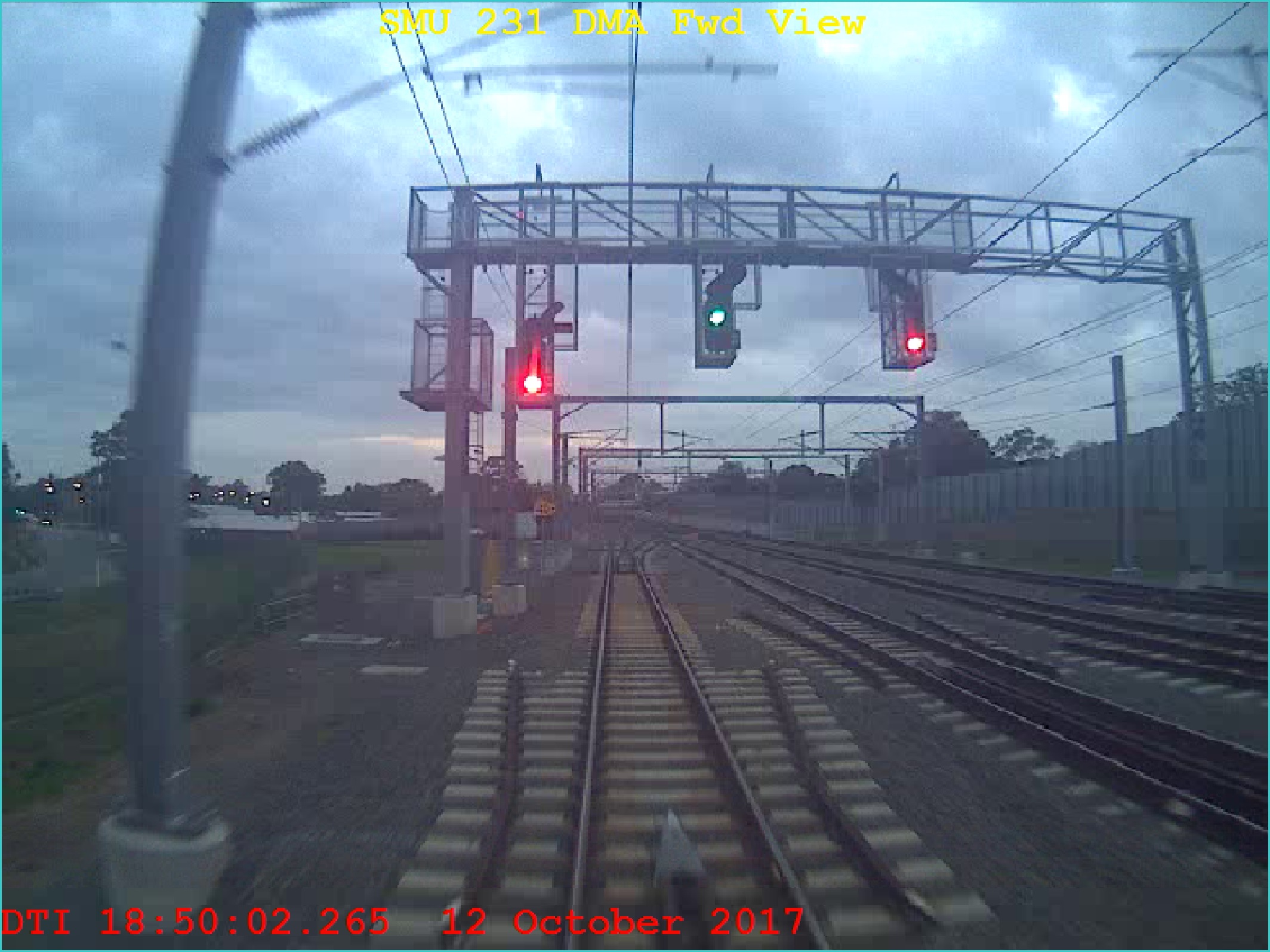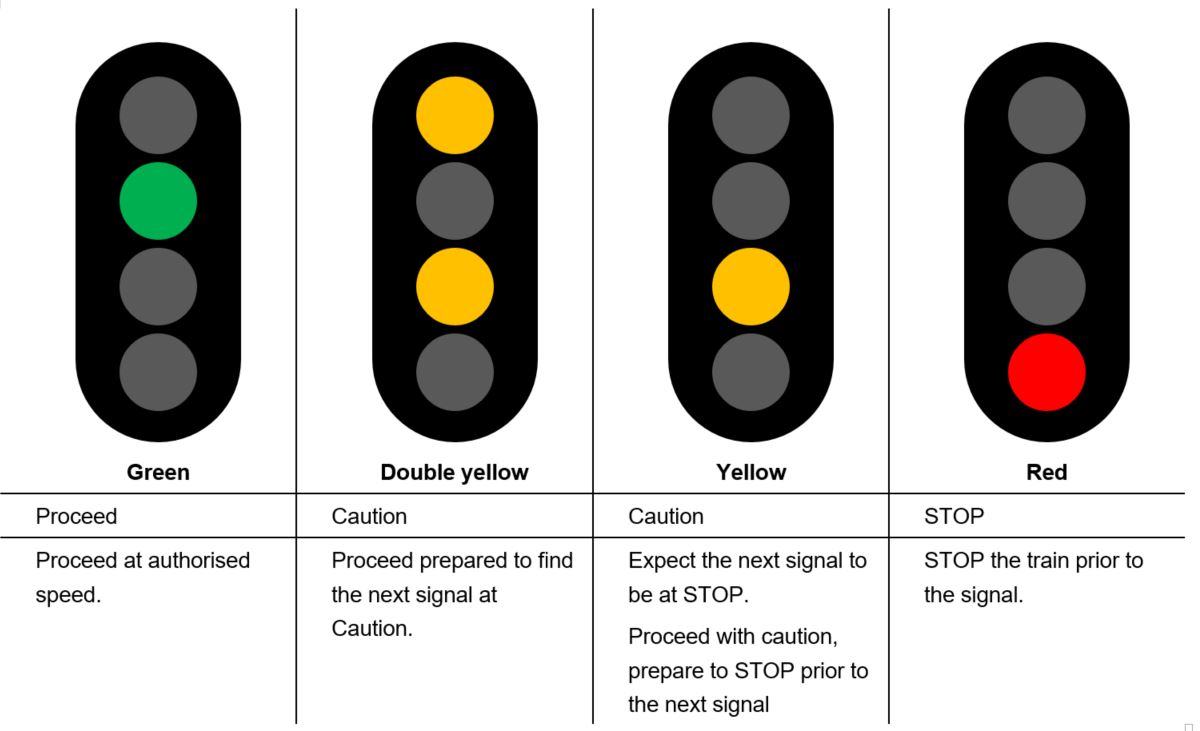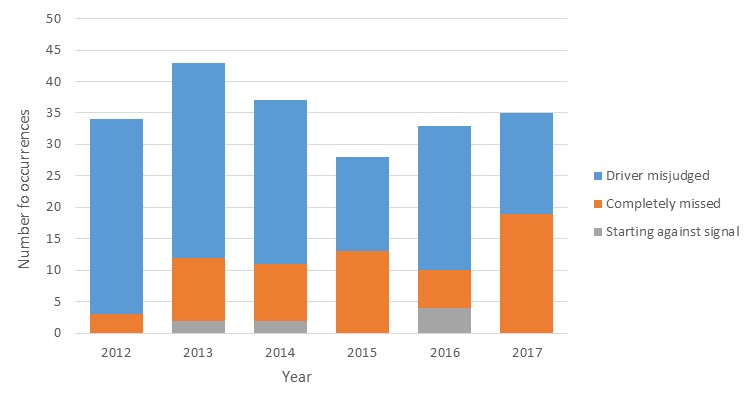Safety summary
What happened
At about 1736 Eastern Standard Time[1] on 12 October 2017, Queensland Rail (QR) empty suburban passenger train 2552 departed Kippa-Ring Station towards Bowen Hills. The train ran on Proceed signal indications (green) until slowing for a sweeping curve into Petrie Station. The driver of train 2552 recalled slowing the train approaching Petrie platform then following yellow signals. The Automatic Warning System (AWS) [2] generated an in-cab alert to the driver of the restricted signal indication ahead on signal PE54 on the departure side of Petrie Station platform 5. The driver acknowledged the AWS, passed signal PE54 (which displayed a restricted indication double yellow aspect)[3] and continued towards the next signal PE38. The driver did not recall acknowledging the AWS associated with PE54.
Figure 1: Train 2552 passing signal PE54 at 1748:53, travelling at a speed of 41 km/h

Source: Queensland Rail
Approaching signal PE38, the AWS activated again, indicating the next signal PE38 was also displaying a restricted indication (single yellow aspect). The driver acknowledged the AWS, passing signal PE38 at 41 km/h (Figure 2). Again, the driver could not recall acknowledging the AWS.
Figure 2: Train 2552 passing signal PE38 at 17:49:12 travelling at a speed of 41 km/h

Source: Queensland Rail
The train continued towards the next signal, PE28, at a stable speed of about 41 km/h, below the posted speed limits of 60 km/h and 70 km/h respectively.
At about 1750, train 2552 passed signal PE28 at STOP (Figure 3), and continued at a reduced cautious speed. The driver did not recall the red signal or acknowledging the associated AWS alarm. The driver commented that he was focussed on the preceding train and not the signal indication directly in front.
In response to exceedance of the STOP signal, an alarm activated in the QR Rail Management Centre. The network control officer (NCO) managing that sector immediately broadcast an emergency radio message calling for the driver of train 2552 Petrie to stop. The driver of train 2552 heard the emergency broadcast but thought the message was for another train. Specifically, the driver believed that the NCO was calling train 2Y52 at Petrie, not train 2552 that was nearer to Lawnton. The NCO broadcast another emergency message to the driver and guard of train 2552. The driver as a precaution slowed further to about walking pace, but did not completely stop. Due to the slow speed of the train, the guard advised the NCO that the train was stopping. A short time later however, the driver began to move off. In response, the guard opened the brake pipe cock, causing an emergency brake application that brought the train to a complete stop at 1751. The train stopped about 320 m past signal PE28, about 83 m prior to the converging points onto the up main line.
The adjacent up main line route had been set for the passage of passenger train TK74. At the time of the SPAD, when there was the possibility of train 2552 converging onto the main line route, train TK74 was several kilometres away. After the SPAD, the NCO returned protecting signals to STOP to protect the line and the approaching train TK74.
At 1808, train 2552 drove back clear of signal PE28. The NCO verified with the driver of train 2552 that he could continue to Bowen Hills. At 1815, the train continued its planned journey to Bowen Hills. The guard joined the driver in the cab at Lawton, the next station, and travelled until Strathpine. At Strathpine, a train operations inspector joined the train and supervised the driver for the remainder of the journey to Bowen Hills. At Bowen Hills, the train crew were removed from duty. The driver advised the ATSB that he was feeling unwell at the time of the occurrence and that he subsequently was diagnosed with a severe respiratory tract infection.
Figure 3: Train 2552 passing signal PE28 1750:02 travelling at a speed of at 42 km/h

Adjacent signal PE26 cleared (green) for train TK74.
Source: Queensland Rail
Signalling system
The QR signalling system at Petrie comprised of a four aspect signalling system, shown in Table 1.
Table 1: Four aspect signalling system indications

When passing Caution signals, drivers are required to reduce train speed to 75 per cent of the designated track speed. In this instance, the driver reduced speed to negotiate a curve approaching Petrie station, rather than because of the Caution signal. The driver maintained a reduced speed below 75 per cent of designated track speed until stopped.
Risk Triggered Commentary Driving (RTCD)
Risk Triggered Commentary Driving (RTCD) is a Queensland Rail risk mitigation procedure aimed to assist drivers to maintain vigilance and awareness when managing operational risks while driving trains.
Primarily, RTCD was developed to manage risks while running on restricted signals, but may also include managing adverse conditions or managing operational risks. Additionally, RTCD is used to reduce the risk of drivers automatically acknowledging the AWS. The RTCD involved drivers acknowledging the aspect of the restricted signal, and intended actions, by speaking aloud.
The driver of train 2552 reported that, while he was familiar with RTCD practices, he did not verbalise his thoughts about restricted signals encountered during the occurrence journey.
Driver training
Training records for the driver of train 2552 indicated that RTCD training was delivered in July 2012. However, other than periodic maintenance of competency (MoC) line checks, no other RTCD training or refresher had been provided, nor was it required to be. The most recent MoC line check was conducted on 27 July 2017.
The MoC line check involved written and practical components. The written component of the MoC consisted of four questions. Each question involved completing the missing word/s in a statement. The practical assessment consisted of a number of direct observations by an assessor and checked against listed competencies, which included aspects of RTCD and actions verbalised. In each component, the driver of train 2552 was assessed as competent.
SPAD history
Following the commencement of two SPAD-related investigations (RO-2017-012,[4] and (RO-2017-010)[5] involving QR operations, the ATSB reviewed past occurrence data to determine if there was an increase in the SPAD rate.
The Kippa-Ring line opened in October 2016. Signal PE28 formed part of the new infrastructure installed as part of the new Kippa-Ring line. Consequently, there was no SPAD history for signal PE28.
Within the QR Brisbane suburban passenger network, there were 17 SPAD events[6] recorded between 1 July and 30 November 2017. When compared to similar suburban passenger networks, Metro Trains Melbourne and Sydney Trains, the QR SPAD rate is comparable, as shown in Table 2.
Table 2: ONRSR SPAD data
| July | August | September | October | November* | ||||||
| Ct | Rate | Ct | Rate | Ct | Rate | Ct | Rate | Ct | Rate | |
| Metro Trains Melbourne | 4 | 2.08 | 6 | 3.12 | 2 | 0.99 | 5 | 2.66 | 9 | |
| Queensland Rail | 4 | 2.61 | 5 | 3.17 | 2 | 1.34 | 3 | 1.97 | 3 | |
| Sydney Trains | 4 | 1.83 | 7 | 3.08 | 4 | 1.85 | 4 | 1.78 | 6 |
Note: data provided by Office of the National Rail Safety Regulator (ONRSR) based on information provided by rail operators. *Normalisation data for November was not available. Count (Ct) and rate (Rate) per 106 passenger train km.
Source: ATSB
Additional QR Brisbane suburban passenger network SPAD data was provided by the then-rail regulator, the Queensland Department of Transport and Main Roads (TMR),[7] and the Office of National Rail Safety Regulator (ONRSR). Within the data, the ATSB focused on analysing three types of train driver-related SPADs between January 2012 and December 2017: ‘starting against signal’,[8] ‘driver misjudged’,[9] and ‘driver completely missed’.[10] The results are shown in Figure 4.
Figure 4: Queensland train driver-related SPAD occurrences, 2012 – 2017

Note: data provided by TMR and ONRSR based on information provided by the rail operator.
Source: ATSB
The highest proportion of driver-related SPAD occurrences was ‘driver misjudged’, followed by ‘completely missed’, then ‘starting against signal’. The ‘completely missed’ SPAD occurrence is considered by QR to be a higher risk. As a proportion of all driver-related SPADs, the ‘completely missed’ SPADs represented 9% in 2012, 23% in 2013, 24% in 2014, 46% in 2015, 18% in 2016 and 54% in 2017. Based on the five-year average of completely missed SPADs (2012-2016), the data showed an increasing proportion of ‘completely missed’ SPADs in 2017.
Although the increase in 2017 was higher than previous years, there was insufficient data to conclude whether this was an anomaly or indicative of an increasing trend. Ongoing monitoring of this occurrence type will resolve this.
Office of the National Rail Safety Regulator SPAD categories
From 1 July 2018, the way SPADs are categorised and reported to the Office of the National Rail Safety Regulator (ONRSR) will change. Under the new categorisation, SPADs will be assessed on possible consequence and categorised into eight subcategories.
Additionally, SPAD vulnerability data must be provided for each SPAD, based on consideration of the severity and probability of their actual and possible consequences.[11]
Under the new categorisation, this occurrence could be categorised as a ‘level H - Minor’:
- H. SPAD rolling stock stopped more than 50 metres in rear of the first potential conflict point by the actions of the Network Control Officer (NCO) prior to incident.
- Minor: significant escalation of SPAD required before incident could occur.
Safety analysis
The driver of train 2552 unknowingly passed signal PE28 at stop. The driver recalled he was planning the train handling with a focus on the movement of the train ahead, rather than the signalling system. He also reported feeling unwell. The extent to which the driver’s reported area of focus and his developing illness influenced the occurrence could not be determined. Both these elements however, had the potential to distract the driver’s attention from the light signals.
The driver was aware of RTCD practices and reported applying them internally.
The driver did not recall acknowledging the AWS alarms. Notwithstanding this, if the alarm was not acknowledged within a certain time, a penalty brake application would be made automatically. The recorded data did not show a penalty brake application. Therefore, the ATSB concluded that the AWS alarms were acknowledged.
In response to the exceedance of the signal, the network control officer broadcast an emergency message for train 2552 to stop. The response to that broadcast was delayed as the driver believed it was directed to the crew of another train. The action of the guard opening the brake pipe cock, causing an emergency brake application, was a positive action that prevented a potentially more serious incident.
Findings
These findings should not be read as apportioning blame or liability to any particular organisation or individual.
- The driver of train 2552 did not recall seeing a red light as they approached signal PE28 resulting in that signal being passed at stop. The exceedance may have been influenced by a focus of attention on the preceding train and a developing respiratory illness.
- The network control officer responded to the SPAD by broadcasting an emergency message for train 2552 to stop. The driver did not respond to that call as they believed it was directed to another train, however the guard responded to the broadcast by activating the emergency brakes.
Safety action
Whether or not the ATSB identifies safety issues in the course of an investigation, relevant organisations may proactively initiate safety action in order to reduce their safety risk. The ATSB has been advised of the following proactive safety action in response to this occurrence.
Queensland Rail
Queensland Rail advised the ATSB that as a result of a series of SPAD events, they are:
- Conducting a qualitative analysis of the SPAD scenarios at RS57 using a bowtie model.
- Presenting a health and wellbeing strategic plan to the Executive Leadership Team, which includes an organisational resilience and psychological wellbeing education and awareness program.
- Conducting a human factors review of driver response to AWS audible indications and reaction times for green and restricted signals.
- Facilitating the decrease in volume of the AWS audible indication at a proceed signal (green) and increasing the volume of an AWS audible indication at a restricted signal (double yellow, yellow, and red).
- Seeking expressions of interest from market leaders to partner with Queensland Rail to implement European Train Control System (ETCS) on sections of the Queensland Rail network. ETCS incorporates automatic train protection that provides for monitoring of train speed and limits of authority to ensure trains stay within designated speed limits and authorised safeworking limits.
Safety message
Driving trains is a complex task, particularly during times of critical safety such as restricted signals. The AWS engineered system alerts the driver before a restricted signal indication. Regular activation of any warning system however, increases the risk that it will be acknowledged without consideration of the related hazard. The proposed introduction of ETCS by Queensland Rail removes the human element from the decision making process. If a train approaches a restricted signal too fast, and no or improper action is taken by the driver, the brakes are automatically applied, stopping the train before danger.
Purpose of safety investigationsThe objective of a safety investigation is to enhance transport safety. This is done through:
It is not a function of the ATSB to apportion blame or provide a means for determining liability. At the same time, an investigation report must include factual material of sufficient weight to support the analysis and findings. At all times the ATSB endeavours to balance the use of material that could imply adverse comment with the need to properly explain what happened, and why, in a fair and unbiased manner. The ATSB does not investigate for the purpose of taking administrative, regulatory or criminal action. TerminologyAn explanation of terminology used in ATSB investigation reports is available here. This includes terms such as occurrence, contributing factor, other factor that increased risk, and safety issue. Publishing informationReleased in accordance with section 25 of the Transport Safety Investigation Act 2003 Published by: Australian Transport Safety Bureau © Commonwealth of Australia 2018
Ownership of intellectual property rights in this publication Unless otherwise noted, copyright (and any other intellectual property rights, if any) in this report publication is owned by the Commonwealth of Australia. Creative Commons licence With the exception of the Coat of Arms, ATSB logo, and photos and graphics in which a third party holds copyright, this publication is licensed under a Creative Commons Attribution 3.0 Australia licence. Creative Commons Attribution 3.0 Australia Licence is a standard form licence agreement that allows you to copy, distribute, transmit and adapt this publication provided that you attribute the work. The ATSB’s preference is that you attribute this publication (and any material sourced from it) using the following wording: Source: Australian Transport Safety Bureau Copyright in material obtained from other agencies, private individuals or organisations, belongs to those agencies, individuals or organisations. Where you wish to use their material, you will need to contact them directly. |
__________
- Eastern Standard Time (EST): Coordinated Universal Time (UTC) + 10 hours.
- The AWS is part of the signalling system and the in-cab system warns the driver whether the next signal is clear or restricted. The AWS utilises magnets, which are placed in the track generally 80m before the signal, which the AWS repeats.
- Caution – proceed to find the next signal at caution.
- Signal RS57 passed at danger involving suburban passenger train 1W33, Roma Street Station, Queensland on 5 September 2017. www.atsb.gov.au/publications/investigation_reports/2017/rair/ro-2017-012/
- Signal ME45 passed at danger, involving suburban passenger train 1A21, Bowen Hills, Queensland, on 26 August 2017. www.atsb.gov.au/publications/investigation_reports/2017/rair/ro-2017-010/
- Recorded SPAD events are restricted to driver-error related.
- Queensland TMR was the rail regulator in Queensland until 1 July 2017, after which ONRSR assumed the role.
- Where a stationary train starts and proceeds beyond a signal at danger without authority. The driver may or may not realise that the train has run past the signal.
- Where the driver has attempted to stop the train but failed to stop the train before passing the signal.
- Where no attempt has been made to bring a train to a stand before the stop signal and the train has proceeded into the next section or block without the necessary authority. The driver has not realised that the train has passed a stop signal until a more serious event results; the driver is stopped by train control over the radio or at the next signal or stopped by other external intervention.
- ONRSR Reporting Requirements for Notifiable Occurrences pages 154 and 155. www.onrsr.com.au/safety-improvement/signals-passed-at-danger


